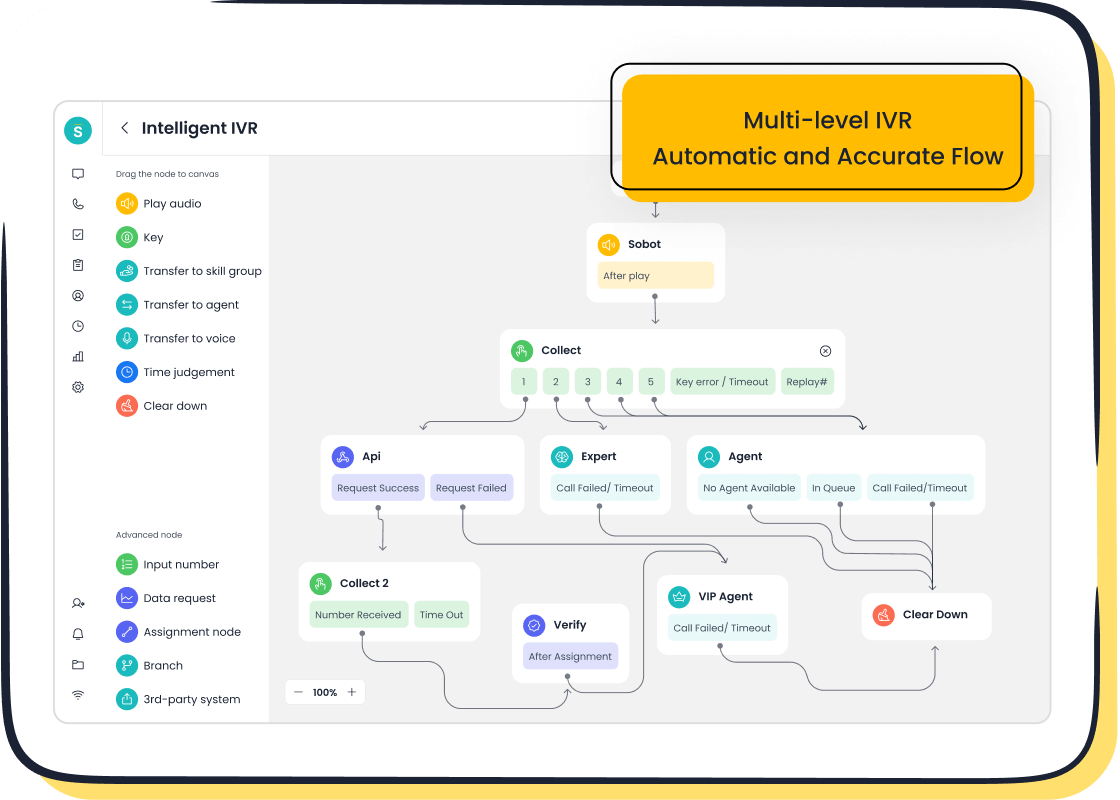Proven Steps to Handle Customer Service Issues Efficiently

When customers face issues, how you respond can make or break their trust in your brand. Resolving customer service problems effectively not only builds loyalty but also transforms complaints into opportunities. Did you know 80% of customers are more likely to return if their complaints are resolved quickly? That’s the power of effective complaint management. By handling customer complaints with care, you can exceed expectations and create lasting impressions. With Sobot, you can learn the steps for handling customer complaints efficiently. Let’s dive into how you can deliver a high level of customer service and boost customer satisfaction.
Actively Listen to Customer Complaints
Listening is the foundation of excellent customer service. When you actively listen to customer complaints, you show that their concerns matter. This simple act can transform a frustrated customer into a loyal advocate for your brand. Let’s explore how you can master this skill.
Create a Welcoming Environment for Feedback
Customers need to feel comfortable sharing their concerns. Start by creating a positive and open atmosphere. Use a friendly tone and invite them to share their thoughts. For example, phrases like, “We value your feedback” or “Please tell us more about your experience” can encourage them to open up.

A welcoming environment also improves the quality of feedback. Studies show that businesses focusing on customer-centric practices, like encouraging feedback, see a 20% boost in satisfaction. By actively seeking input through surveys or direct conversations, you gain valuable insights into customer needs. Tools like Sobot’s Voice/Call Center make this process seamless by integrating feedback channels into one platform.
Avoid Interrupting and Take Notes
Interrupting a customer mid-sentence can make them feel unheard. Instead, let them speak freely. While they talk, jot down key points. This shows you’re paying attention and helps you address their concerns accurately.
Taking notes also prevents miscommunication. Imagine a customer explaining a billing issue. If you’ve noted the details, you can quickly verify the problem and offer a solution. Sobot’s unified workspace simplifies this process by organizing customer data and interactions in one place, ensuring nothing gets overlooked.
Use Verbal and Non-Verbal Cues to Show Engagement
Your words and body language speak volumes. Verbal cues like “I understand your frustration” or “Let’s resolve this together” show empathy. Non-verbal cues, such as maintaining eye contact, smiling, and nodding, reinforce your attentiveness.

Research highlights that non-verbal communication accounts for 55% of how messages are received. A calm tone can ease tension, while an abrupt one can escalate it. With Sobot’s AI-powered Voicebot, you can even automate empathetic responses, ensuring every interaction feels personal.
By mastering these techniques, you’ll excel at handling customer complaints and building stronger relationships.
Show Empathy and Acknowledge Customer Service Problems

Empathy is the cornerstone of excellent customer service. When you acknowledge the customer complaint and show genuine understanding, you create a connection that fosters trust and loyalty. Let’s explore how you can master this essential skill.
Validate the Customer’s Feelings
Customers want to feel heard and understood. Start by acknowledging their emotions. Phrases like, “I can see how this situation has been frustrating for you,” show that you’re not just addressing the issue but also recognizing their feelings. This simple act can diffuse tension and set a positive tone for the conversation.
"When you show deep empathy toward others, their defensive energy goes down, and positive energy replaces it. That's when you can get more creative in solving problems." – Stephen Covey
Validating emotions isn’t just about words. It’s about listening actively and responding thoughtfully. For example, if a customer is upset about a delayed delivery, you could say, “I understand how important it is to receive your order on time. Let’s work together to resolve this.” This approach not only calms the customer but also builds rapport.
Use Empathetic Language to Build Rapport
The words you choose can make or break the interaction. Empathetic language helps you connect with customers on a personal level. Saying things like, “I hear you” or “That sounds like a challenge” shows that you’re genuinely invested in their concerns. These phrases foster trust and make customers feel valued.
Empathy also plays a critical role in problem-solving. Studies reveal that 70% of buying experiences are based on how customers feel they are treated. By using empathetic language, you can turn a negative experience into a positive one. Tools like Sobot’s AI-powered Voicebot can even automate empathetic responses, ensuring every interaction feels personal and thoughtful.
Avoid Defensive Responses
When handling customer complaints, it’s easy to get defensive, especially if the issue feels unfair. However, defensive responses can escalate the situation. Instead, focus on understanding the problem and finding a solution. For instance, if a customer says, “Your service is terrible,” resist the urge to argue. Instead, reply with, “I’m sorry to hear that. Let’s figure out how we can make this right.”
Defusing tense situations requires patience and professionalism. Empathy helps calm agitated customers and transforms unhappy ones into advocates. By staying calm and focused, you can address customer complaints effectively and leave a lasting positive impression.
Apologize Sincerely and Take Action to Make Things Right
Mistakes happen, but how you respond can define your relationship with customers. A sincere apology paired with prompt action can turn a negative experience into a positive one. Let’s explore how to handle customer complaints with grace and professionalism.
Offer a Genuine Apology Without Making Excuses
When you sincerely apologize to the customer, it shows accountability and respect. Avoid excuses or shifting blame. Instead, acknowledge the issue and express regret. For example, saying, “We’re truly sorry for the inconvenience caused by the delay,” feels more genuine than, “We’re sorry, but it’s not our fault.” Research from Harvard Business Review reveals that authentic apologies make customers more likely to forgive mistakes and continue their relationship with your brand.
A well-crafted apology builds trust. According to Accenture, 48% of customers remain loyal to brands that effectively manage complaints and apologize when necessary. By addressing customer complaints with honesty, you can strengthen your connection with them.
Differentiate Between Personal and Organizational Responsibility
It’s important to clarify whether the issue stems from an individual error or a systemic problem. If it’s a personal mistake, take responsibility and assure the customer it won’t happen again. For example, “I made an error while processing your order, and I’ll fix it immediately.” If it’s an organizational issue, acknowledge it and explain how your team is working to resolve it. This transparency reassures customers that you’re taking action to make things right.
Sobot’s Voice/Call Center can help you track and analyze recurring issues, making it easier to identify whether the problem is personal or systemic. With features like call tracking and real-time monitoring, you can address customer complaints more effectively.
Use Positive Language to Reassure the Customer
Positive language can transform a tense situation into a constructive conversation. Instead of saying, “We can’t fix this right now,” try, “We’re working on a solution and will update you shortly.” Phrases like, “Your satisfaction is our top priority” or “We appreciate your patience while we resolve this matter” show empathy and commitment.
Using positive language not only reassures customers but also improves their overall experience. Tools like Sobot’s AI-powered Voicebot can automate empathetic and positive responses, ensuring every interaction feels personal and thoughtful.
By following these customer complaint handling best practices, you can address customer complaints effectively and build lasting loyalty.
Gather All Necessary Information to Handle Customer Complaints
When a customer reaches out with a complaint, gathering all the necessary details is crucial. It helps you understand the issue fully and ensures you take the right action to resolve it. Let’s break down how you can do this effectively.
Ask Open-Ended Questions to Understand the Problem
Open-ended questions are your best friend when it comes to understanding customer complaints. Instead of asking questions that lead to a simple "yes" or "no," encourage customers to share more details. For example, instead of saying, "Did your order arrive late?" try asking, "Can you tell me more about your experience with the delivery?" This approach gives you a clearer picture of the issue.
Open-ended questions also help customers feel heard. Research shows they encourage detailed responses and allow customers to express their thoughts freely. Whether you're exploring customer feedback, behavior, or even testing new concepts, these questions provide valuable insights. Here's a quick look at their effectiveness:
| Category | Purpose |
|---|---|
| Customer Behavior | Understanding general consumer trends and purchase behavior. |
| Customer Feedback | Understanding what customers feel about your products and services. |
| Concept Testing | Understanding what customers feel about a new concept for a product or feature. |
| Marketing | Understanding the effectiveness of your marketing and advertising campaigns. |
| Competitive Analysis | Understanding how your brand and product stand up against your competitors. |
By asking the right questions, you can uncover the root cause of the problem and work toward a solution.
Confirm Details to Avoid Miscommunication
Miscommunication often leads to unresolved issues and frustrated customers. To prevent this, confirm the details of the complaint after the customer explains their problem. You can do this by repeating back what you’ve understood. For instance, say, "Just to confirm, you’re saying the product arrived damaged, and you’d like a replacement. Is that correct?"
Reflective listening shows customers that you’re paying attention and committed to resolving their concerns. It also helps fill in any gaps in information. Asking follow-up questions like, "Can you clarify when this happened?" ensures you have all the facts. This step not only reduces misunderstandings but also builds trust.

Sobot’s Voice/Call Center makes this process seamless. With features like call tracking and real-time monitoring, you can document and review customer interactions to ensure nothing gets missed.
Document Key Points for Reference
Accurate documentation is essential for resolving customer complaints efficiently. Summarize key points during the conversation and use a consistent format for recording them. This practice helps you track issues, identify patterns, and improve your service over time.
For example, if multiple customers report the same issue, your documentation can help pinpoint the root cause. Regularly updating these records ensures your team has the latest information. Effective documentation not only enhances customer satisfaction but also supports long-term improvements in your processes.
Sobot’s unified workspace simplifies this task by organizing customer data and interactions in one place. This ensures your team can access the information they need to resolve complaints quickly and effectively.
Offer a Solution or Options to Resolve Customer Complaints
When it comes to resolving customer complaints, offering clear solutions and involving customers in the process can make all the difference. Let’s explore how you can handle customer complaints effectively by presenting actionable options and setting realistic expectations.
Present Clear and Feasible Solutions
Customers appreciate clarity. When you offer a solution, make sure it’s straightforward and achievable. For instance, if a customer reports a defective product, you could offer a replacement or a refund. Avoid overpromising or suggesting fixes that aren’t practical. Instead, focus on what you can deliver.
Providing the customer with an effective solution can make them even more loyal than they were before. Additionally, receiving negative feedback from customers can help you identify the root cause of the problem and find ways to improve your business going forward.
Here’s a simple three-step approach to presenting solutions:
- Identify the root cause of the complaint.
- Present a solution to the customer.
- Verify that the solution resolves the issue.

Sobot’s Voice/Call Center simplifies this process. With features like call tracking and real-time monitoring, you can quickly identify issues and propose effective solutions tailored to each customer.
Involve the Customer in Decision-Making
Empower customers by involving them in the resolution process. Ask for their input and provide options. For example, you might say, “Would you prefer a replacement or a refund?” This approach not only builds trust but also ensures the solution aligns with their expectations.
- Best-in-business organizations design their complaint processes with input from customers and employees, fostering teamwork.
- The U.S. Postal Service uses Customer Advisory Councils to gather feedback, improving response quality and reducing costs.
By involving customers, you create a sense of partnership. Sobot’s unified workspace makes this seamless by consolidating customer data, enabling personalized interactions that make customers feel valued.
Set Realistic Expectations for Resolution
Clear communication is key. Let customers know what to expect and when. For instance, if resolving their issue will take three days, communicate this upfront. Setting realistic timelines prevents frustration and builds trust.
- Clients who are informed about what to expect tend to report higher satisfaction levels.
- Clear communication can lead to a 20% increase in client retention.
Sobot’s AI-powered Voicebot can assist by providing automated updates, ensuring customers stay informed throughout the resolution process. This not only enhances satisfaction but also fosters loyalty.
By presenting clear solutions, involving customers, and managing expectations, you can resolve customer complaints effectively and strengthen your relationships.
Follow Up to Ensure Resolution and Customer Satisfaction

Following up with customers after resolving their issues is a crucial step in building trust and loyalty. It shows that you care about their experience and are committed to ensuring their satisfaction. Let’s explore how you can master this step.
Check Back with the Customer After the Issue is Resolved
Reaching out to customers after resolving their complaints demonstrates that you value their feedback and want to ensure everything is in order. A simple follow-up call or email can make a big difference. For example, you could say, “We wanted to check if the solution we provided met your expectations. Is there anything else we can assist you with?”
Statistics highlight the importance of follow-ups:
| Statistic | Description |
|---|---|
| 73% | Consumers expect companies to understand their unique needs and expectations. |
| Over 50% | Consumers are likely to become repeat buyers after a personalized experience. |
| 80% | Business leaders report that consumers spend an average of 38% more when their experience is personalized. |
| 98% | Customers read online reviews for local businesses. |
| 69% | Consumers feel positive about businesses with reviews describing a positive experience. |

By following up, you not only ensure customer satisfaction but also increase the likelihood of repeat business.
Ask for Feedback on the Resolution Process
Feedback is a goldmine for improving your service. When you ask customers about their experience, you gain insights into what worked and what didn’t. Use structured feedback methods to make this process effective. For instance:
- Be clear and specific. Ask questions like, “Was the resolution process quick and easy for you?”
- Balance positive and constructive feedback. Recognize what went well while identifying areas for improvement.
- Follow up promptly. Reach out soon after resolving the issue to keep the feedback relevant.
Encouraging customers to share their thoughts not only helps you refine your approach but also makes them feel valued.
Express Gratitude for Their Patience and Understanding
A little gratitude goes a long way. Thanking customers for their patience and understanding during the resolution process leaves a positive impression. You could say, “We appreciate your patience while we worked to resolve this issue. Your feedback helps us improve.”
Expressing gratitude shows that you respect their time and effort. It also reinforces the idea that their concerns matter to you. This simple gesture can turn a one-time customer into a loyal advocate for your brand.
By following up, gathering feedback, and showing appreciation, you can effectively address customer complaints and strengthen relationships.
Document and Analyze Complaints Using Sobot’s Voice/Call Center
Analyzing customer complaints is a game-changer for improving your service quality. With Sobot’s Voice/Call Center, you can document and analyze complaints efficiently, turning challenges into opportunities for growth. Let’s explore how you can make the most of this powerful tool.
Record Details in a Centralized System
Keeping all complaint details in one place ensures nothing slips through the cracks. Sobot’s Voice/Call Center offers a unified workspace where you can record and access customer interactions effortlessly. This centralized system helps your team stay organized and respond faster.

Imagine a customer reporting a recurring issue. With Sobot, you can pull up their history in seconds, saving time and showing them you care. Plus, the platform’s real-time monitoring ensures you’re always on top of things.
Here’s what businesses have achieved using Sobot:
| Metric | Result |
|---|---|
| Reduction in inbound discussion volume | 20% |
| Increase in positive feedback | 96% + |
| Correct answers rate | Over 80% |
| Customer satisfaction rate | Over 95% |
| Problem resolution rate | 85% |
| Customer happiness rate | 99% |
| Increase in sign-off rate | About 35% |
| Increase in COD collection rate | About 40% |
Use Complaint Data to Identify Trends
Analyzing complaint data helps you spot patterns and address root causes. Sobot’s tools make this process seamless by providing detailed analytics. For example, you can track recurring issues, monitor service quality, and even identify which customer groups face specific challenges.
By recognizing trends, you can allocate resources more effectively and improve your processes. Here are some benefits of analyzing complaint data:
- Pinpoint areas needing improvement.
- Gain insights into customer experiences.
- Monitor service interactions for quality.
- Respond faster to emerging risks.

Ensure Confidentiality and Compliance with Privacy Standards
Protecting customer data is non-negotiable. Sobot’s Voice/Call Center ensures all information is encrypted and stored securely. This commitment to privacy builds trust and keeps you compliant with regulations.
For example, when handling sensitive customer complaints, Sobot’s system safeguards their details while allowing your team to focus on resolving issues. With global telephony support and a 99.99% uptime, you can rely on Sobot for secure and uninterrupted service.
By documenting and analyzing complaints effectively, you’ll not only resolve issues faster but also create a better experience for your customers.
Improve Processes by Analyzing Customer Complaints
Improving your processes starts with learning from customer complaints. By analyzing these issues, you can uncover patterns, fix recurring problems, and create a better experience for your customers. Let’s break it down step by step.
Identify Root Causes of Recurring Issues
Recurring issues often point to deeper problems. To identify the root cause, start by reviewing the complaints you’ve received. Look for patterns. Are customers frequently mentioning delays, product defects, or unclear instructions? These trends can reveal what’s going wrong.
Use tools like Sobot’s Voice/Call Center to track and analyze data. For example, if multiple customers report late deliveries, you can investigate your shipping process. By digging deeper, you’ll uncover the real issue and take steps to fix it. Addressing these root causes not only resolves current problems but also prevents future ones.
Implement Changes to Prevent Future Complaints
Once you know the root cause, it’s time to act. Implement changes that directly address the problem. If customers complain about slow responses, consider adding more support staff or using AI tools like Sobot’s Voicebot to handle simple queries. If a product flaw is the issue, work with your team to improve its design.
Small changes can make a big difference. For example, updating your FAQ page or improving your return policy can reduce frustration. By being proactive, you show customers that you’re committed to solving customer service problems and improving their experience.
Train Staff Based on Lessons Learned
Your team plays a key role in handling customer complaints. Training them based on past issues ensures they’re better prepared for future challenges. Share examples of common complaints and how to resolve them. Role-playing exercises can help your staff practice handling tough situations.
Use insights from tools like Sobot’s analytics to guide your training. For instance, if data shows that customers value quick resolutions, focus on teaching your team how to respond efficiently. Well-trained staff not only resolve issues faster but also leave a positive impression on your customers.
By identifying root causes, making changes, and training your team, you’ll turn complaints into opportunities for growth. This approach strengthens your processes and builds trust with your customers.
Effectively resolving customer complaints is your gateway to building trust and loyalty. By actively listening, showing empathy, and offering clear solutions, you can turn customer service problems into opportunities. Following up and analyzing complaints ensures continuous improvement and higher customer satisfaction.
Sobot’s Voice/Call Center simplifies this process. Its unified workspace, real-time monitoring, and AI-powered tools help you handle customer complaints efficiently. With features like call tracking and data analytics, you can identify trends and improve your service quality.
Start implementing these steps today. Use Sobot’s solutions to enhance your processes and boost customer satisfaction. Your customers will notice the difference, and so will your business.
Explore Sobot’s Voice/Call Center to transform your customer service experience.
FAQ
What is the best way to handle an angry customer?
Start by staying calm and listening actively. Let them express their concerns without interruption. Use empathetic language like, “I understand how you feel.” Offer a solution or options to resolve the issue. Tools like Sobot’s Voice/Call Center can help streamline this process.
How can Sobot’s Voice/Call Center improve complaint resolution?
Sobot’s Voice/Call Center centralizes customer interactions, making it easier to track and resolve complaints. Features like call tracking, real-time monitoring, and AI-powered Voicebot ensure faster resolutions. It also helps identify recurring issues through data analytics, improving your overall service quality.
Why is following up with customers important?
Following up shows you care about their experience. It ensures the issue was resolved to their satisfaction. A simple call or email can build trust and loyalty. Sobot’s tools make it easy to automate follow-ups, saving you time while keeping customers happy.
How does empathy impact customer service?
Empathy helps you connect with customers on a personal level. It diffuses tension and builds trust. Phrases like, “I understand how frustrating this must be,” show you care. Sobot’s AI-powered Voicebot can even automate empathetic responses, ensuring every interaction feels personal.
Can Sobot’s solutions help prevent future complaints?
Absolutely! Sobot’s analytics tools identify trends and root causes of complaints. This helps you make informed changes to your processes. By addressing recurring issues, you can improve customer satisfaction and reduce the likelihood of future complaints.
See Also
Enhancing Customer Satisfaction Through Effective Live Chat Tips
A Comprehensive Guide to Implementing Omnichannel Contact Solutions
Selecting the Right Social Media Customer Service Software Tips
Best Practices for Effective Quality Management in Call Centers